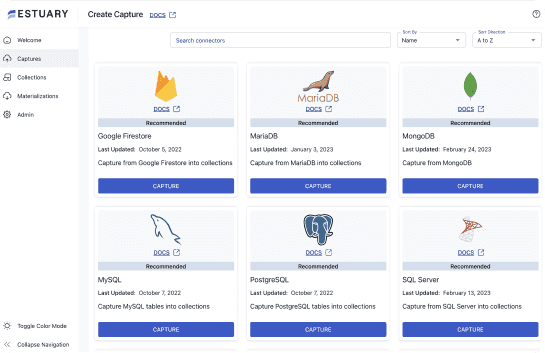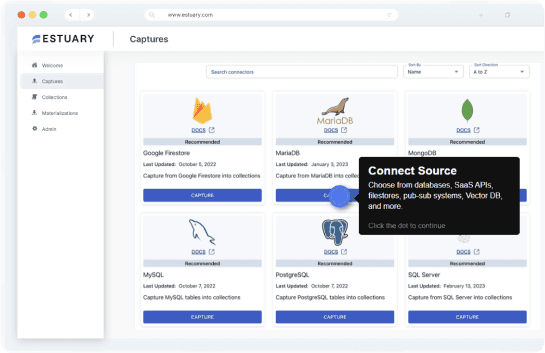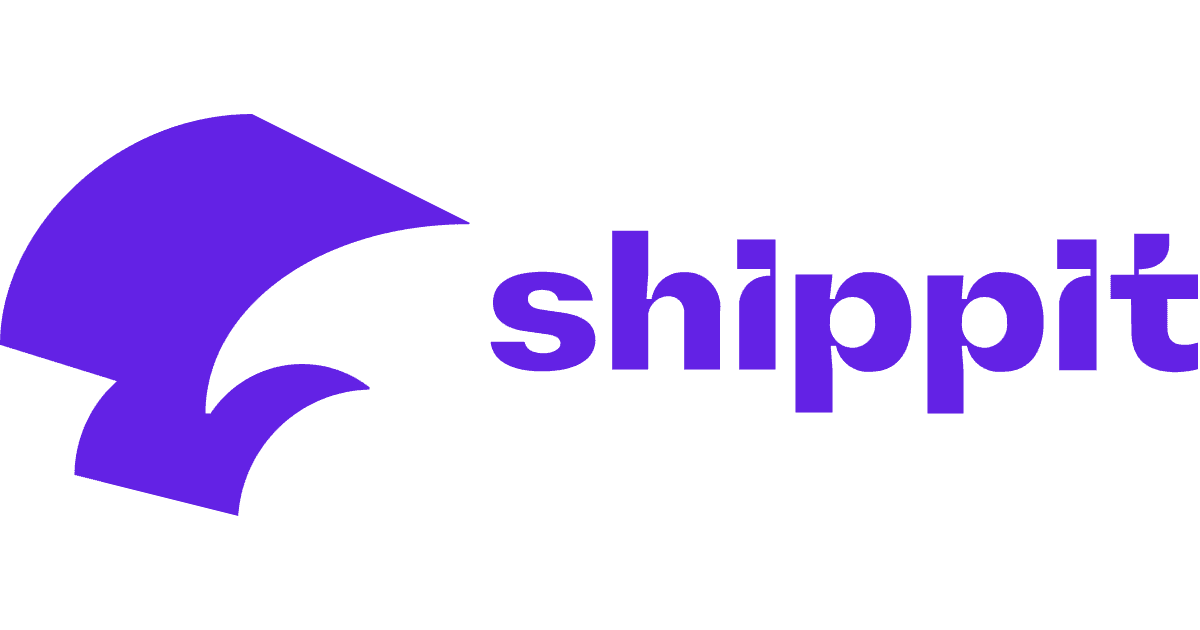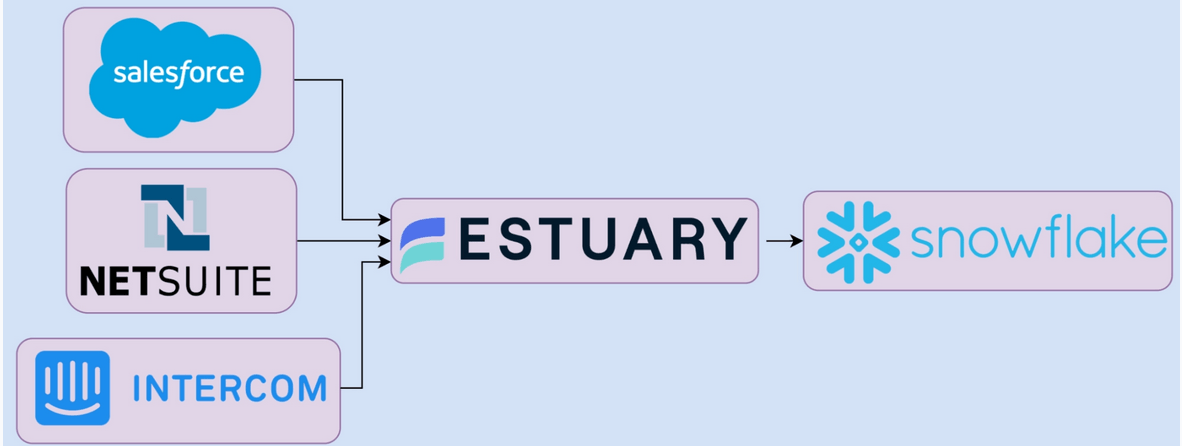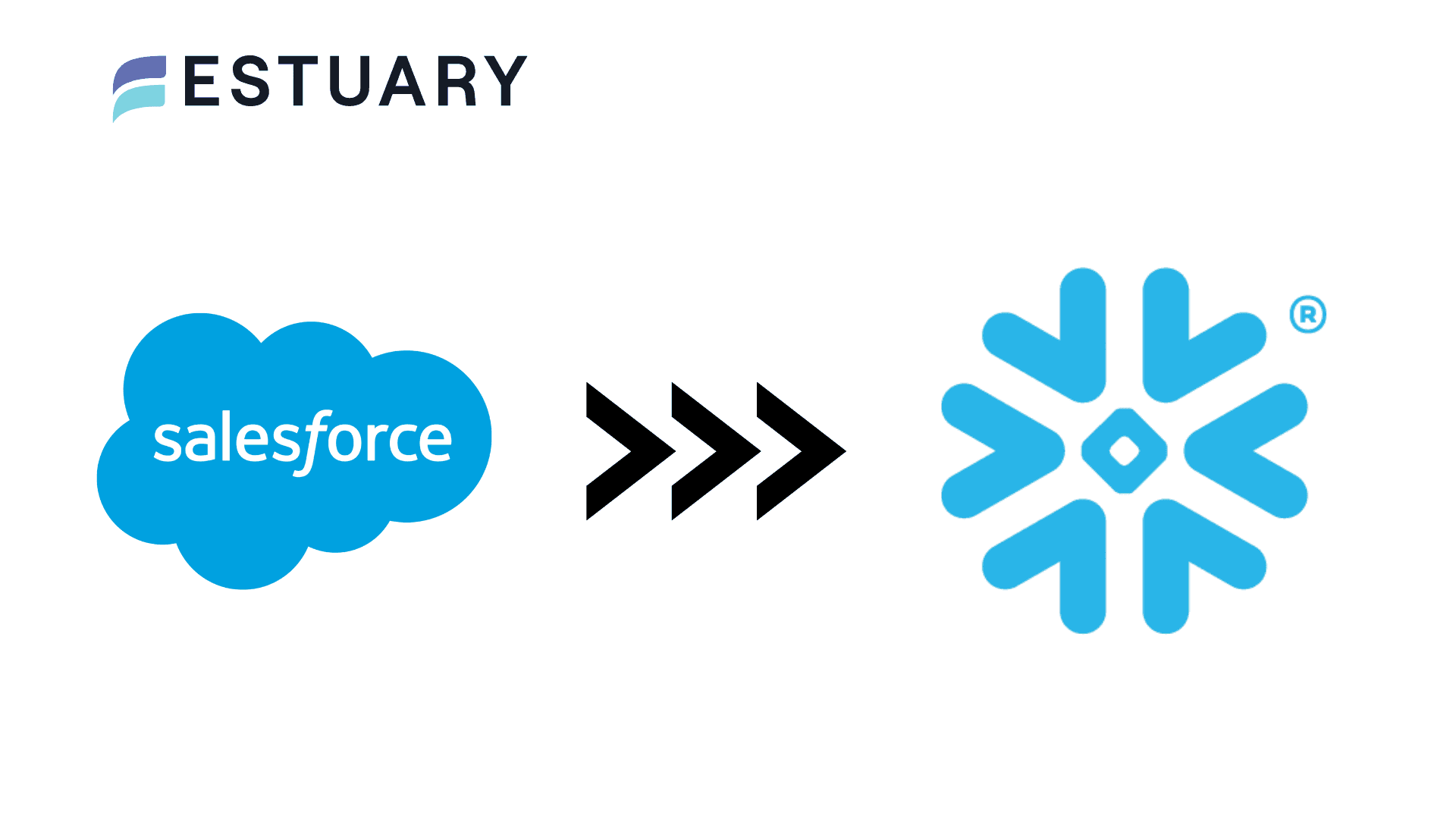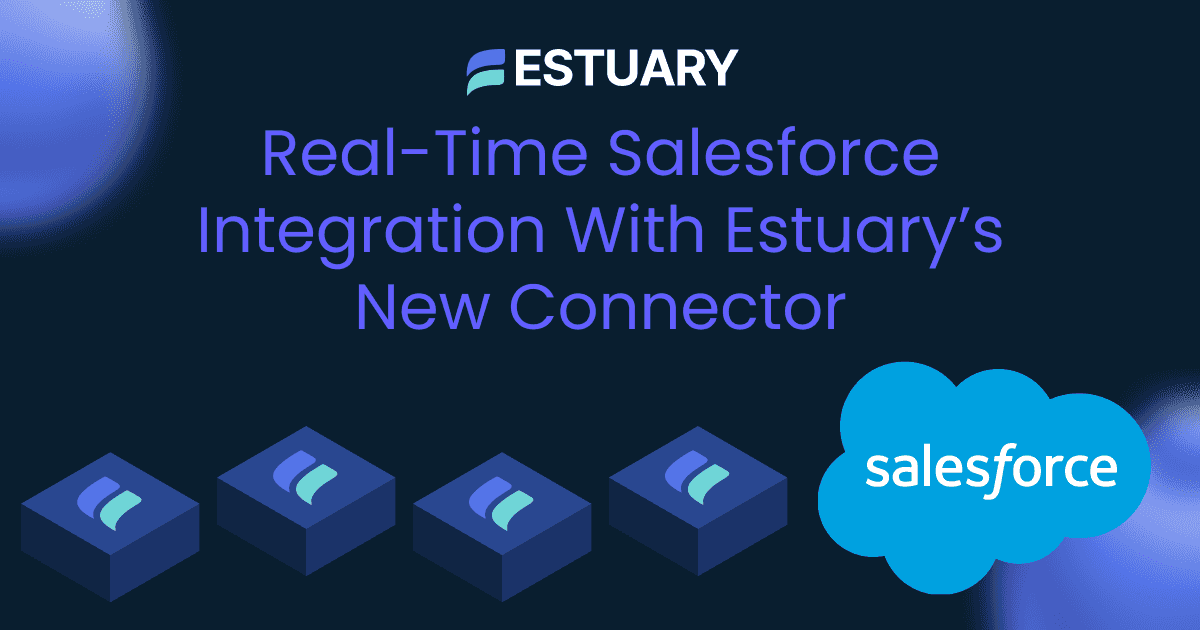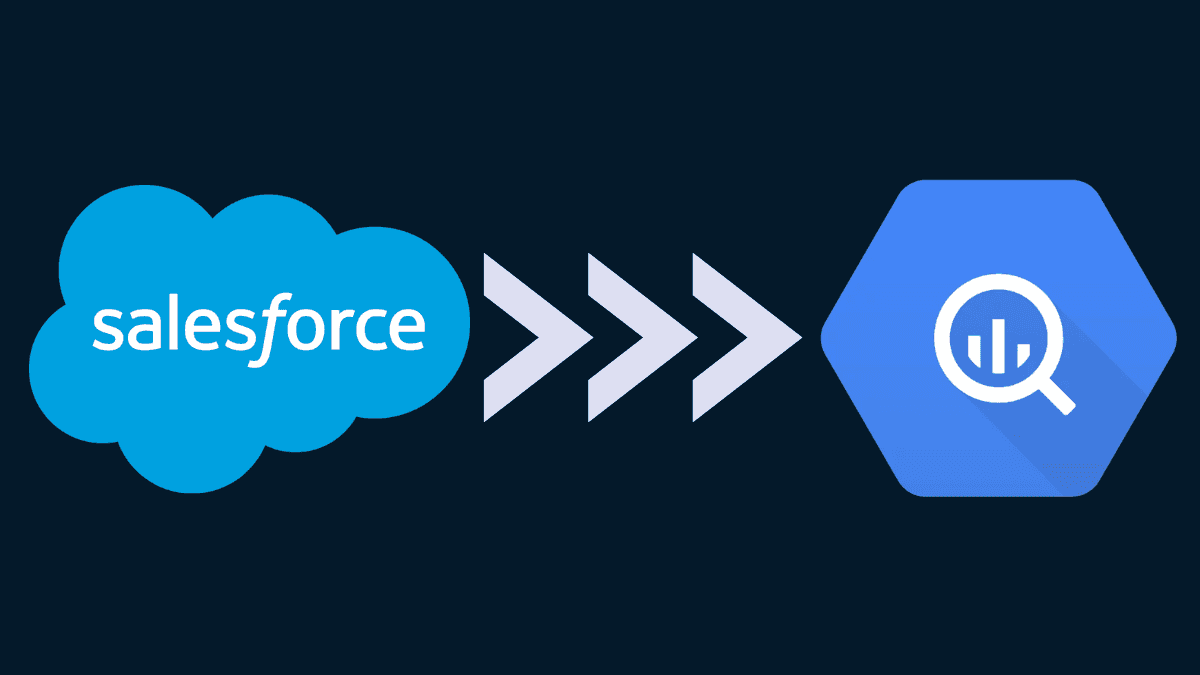
Introduction: Why Your Salesforce Connector Choice Matters
Salesforce is the backbone of customer relationship management for thousands of companies, powering sales, service, and marketing operations. But getting that data out of Salesforce and into analytics platforms like Snowflake or BigQuery, especially in real time, isn’t always straightforward. Many teams rely on tools like the Fivetran Salesforce connector to move CRM data downstream. But as data needs evolve, particularly with the growing demand for real-time insights, it's worth asking: is Fivetran still the best option?
In this article, we’ll compare Fivetran’s Salesforce connector with the real-time Salesforce connector from Estuary Flow. You’ll get a side-by-side look at features, API usage, formula field handling, sync latency, pricing models, and security options so you can make an informed decision quickly.
Whether you're frustrated with batch sync delays or concerned about escalating MAR (Monthly Active Rows) costs, this guide will help you determine the right tool for your Salesforce data strategy.
Overview of Both Tools
When it comes to integrating Salesforce with your analytics stack, both Fivetran and Estuary Flow offer viable solutions. However, they take fundamentally different approaches to data movement, and those differences matter.
Fivetran: ELT Platform
Fivetran is a widely used cloud-based ELT solution that automates data integration through prebuilt connectors. The Fivetran Salesforce connector is designed to replicate Salesforce data into a destination like Snowflake, BigQuery, or Redshift for analysis. It works on a scheduled sync model, using a combination of the Salesforce REST API and Bulk API, and is optimized to minimize API consumption.
Fivetran is popular among teams that value its managed infrastructure and easy setup. But its syncs operate on a batch model, which may not be ideal for time-sensitive workflows. Additionally, certain limitations around formula fields, incremental updates, and pricing complexity can be roadblocks as data volumes scale.
Estuary Flow: Real-Time Streaming Without the Complexity
Estuary Flow is a real-time data movement platform that goes beyond batch pipelines. It captures, transforms, and syncs data continuously using modern change data capture (CDC) patterns, cloud-native stream processing, and integrations with systems like Salesforce.
The Estuary Salesforce connector combines Bulk API 2.0 and REST API for fast, low-latency data capture while staying within API quota limits. It also supports automated formula field refresh, dynamic schema handling for custom fields, and backfills that run in parallel across multiple objects. Flow is designed to deliver both real-time responsiveness and enterprise-grade scalability, without requiring users to write or manage custom logic.
Whether you need to populate dashboards with live Salesforce data, enrich CRM records with external signals, or sync leads into a data warehouse instantly, Estuary Flow makes it possible with a no-code experience.
Feature-by-Feature Comparison: Fivetran vs Estuary Salesforce Connector
To make your decision easier, here is a side-by-side comparison of key features offered by the Fivetran Salesforce connector and Estuary Flow’s real-time Salesforce connector.
Feature | Fivetran Salesforce Connector | Estuary Flow Salesforce Connector |
| Integration Type | Batch-based ELT | Real-time streaming and batch |
| API Usage | REST API and Bulk API v1.0 | Bulk API 2.0 and REST API, optimized for low usage |
| Formula Field Handling | Not incrementally captured; needs manual transformation | Automatically refreshed on a configurable schedule |
| Custom Fields | Supported | Supported with advanced type detection |
| Schema Drift Handling | Manual monitoring required | Automatic schema inference and updates |
| Backfill Performance | Time-consuming and resource-heavy | Parallel, high-speed backfills with minimal API calls |
| Sync Frequency | Fixed intervals (e.g. every 5 min) | Sub-minute real-time syncs |
| Reverse ETL | Limited support | Supported (real-time sync back to Salesforce or elsewhere) |
| Security and Networking | SaaS and Hybrid with Business Critical plan | SaaS, Private Cloud, and BYOC with VPC peering or PrivateLink |
| Deployment Flexibility | Cloud-hosted only | Flexible: Public Cloud, Private Deployment, or Bring Your Own Cloud |
| Pricing Model | Monthly Active Rows (MAR) | Transparent, volume-based pricing |
| Setup Complexity | No-code setup, but formula fields require transformation | No-code setup with built-in support for formulas and schema evolution |
This table shows the critical differences that matter when syncing high-value Salesforce data. Estuary Flow is designed for teams that want real-time visibility, efficient syncs, and full control over infrastructure and costs.
How They Handle the Hard Stuff
Syncing Salesforce data isn't just about copying tables. Real-world teams face challenges like unreliable formula fields, API quotas, evolving schemas, and the need for fast backfills. Let’s break down how the Fivetran Salesforce connector and Estuary Flow handle these complexities.
1. Formula Fields
Fivetran: Formula fields in Salesforce are calculated at query time and don’t trigger changes in the record’s timestamp. As a result, Fivetran cannot incrementally sync them. To include formula fields in analytics, users must write and maintain SQL-based transformations using helper tables like FIVETRAN_FORMULA and FIVETRAN_FORMULA_MODEL.
Estuary Flow: Flow automatically refreshes formula fields on a schedule you define (default is daily). It fetches the current values across all relevant records and merges them into your data pipeline without needing any manual transformation. This approach ensures accurate and up-to-date analytics, especially when formula values change frequently.
⚙️ Want to see how automatic formula field refresh actually works?
Book a personalized demo and get your questions answered.
2. API Quota Management
Fivetran: Fivetran uses both REST and Bulk APIs. It falls back between them depending on volume or failure conditions. To avoid exceeding API limits, it delays syncs or reverts to REST API when usage hits 90% of the daily quota. This reactive behavior may lead to sync delays during high-volume periods.
Estuary Flow: Estuary is optimized to consume fewer API calls. It uses Salesforce Bulk API 2.0, which supports larger batches (up to 150MB) and asynchronous job submission. In one benchmark, syncing over 1,000 lead records used only 354 API calls. This efficiency is critical for large Salesforce orgs with tight API ceilings.
3. Schema Drift and Custom Fields
Fivetran: If a new field is added or renamed in Salesforce, it may not be captured immediately. Manual intervention, including modifying sync settings or handling downstream errors, is often required. Pipelines may break silently if not monitored.
Estuary Flow: Flow continuously infers schemas during sync and automatically adjusts to changes. It captures custom objects and fields with precise type mapping, making it reliable in heavily customized Salesforce environments.
4. Backfills
Fivetran: Backfills follow fixed policies and rely on slow batch imports. Some objects are re-imported weekly or even daily, depending on sync time. Formula fields, non-replicateable objects, or complex tables may require special support requests.
Estuary Flow: Flow performs parallel backfills across multiple objects using Bulk API 2.0. This significantly reduces total sync time. Backfills are optimized to avoid rate limits while capturing full historical data, making Estuary a great fit for both fresh pipelines and legacy data migration.
Real-Time Use Case: Salesforce to Snowflake
To understand the difference between the Fivetran Salesforce connector and Estuary Flow, let’s walk through a practical scenario. Imagine your marketing and sales teams rely on a Snowflake dashboard that shows the most up-to-date Salesforce Lead data, including custom fields like lead scores and enterprise account flags.
Using Fivetran
With Fivetran, the sync runs in batches. Even with a five-minute interval, the data could be outdated by the time it hits Snowflake. Formula fields such as LeadScore__c and Is_Enterprise_Account__c are not updated unless you manually transform them downstream using SQL models. This delay can create misalignment in campaign targeting, lead qualification, or sales follow-ups.
If a lead’s status or score changes, that update may not show up until the next batch runs and transformations complete. And if API quotas are tight, syncs may be deferred, introducing further lag.
Using Estuary Flow
With Estuary, the same Lead data is captured in real time. Changes to standard fields are streamed immediately. Formula fields like LeadScore__c are automatically refreshed on a daily schedule (or more frequently if needed) and merged into the Lead collection. You don’t need to write any transformations or set up a separate workflow.
In one test case, after updating Alice Smith’s Lead status in Salesforce from “New” to “Working - Contacted,” the change appeared in Snowflake within minutes. The formula-based LeadScore__c was also updated without needing a full re-sync.
Here’s what a real query in Snowflake might look like after the sync:
plaintextSELECT Name, Company, Status, LeadScore__c, Is_Enterprise_Account__c,
CASE WHEN LeadScore__c > 60 THEN TRUE ELSE FALSE END AS IsQualified__c
FROM salesforce_leads.lead
ORDER BY CreatedDate DESC;This gives marketing and sales teams live visibility into their pipeline, helps personalize outreach, and enables instant decision-making. Estuary’s approach makes it possible without batch delays or complex pipeline maintenance.
🚀 See your Salesforce data in Snowflake within minutes.
Start building with Estuary Flow for free — no credit card required.
Security, Governance, and Deployment Flexibility
When it comes to syncing sensitive Salesforce data, both security and infrastructure control matter. Here’s how Fivetran and Estuary Flow compare on the essentials.
Fivetran Salesforce Connector
- Offers SaaS by default. Hybrid deployments are available, but only for Enterprise or Business Critical plans.
- Private networking like AWS PrivateLink requires additional Salesforce licensing and top-tier pricing plans.
- Data always flows through Fivetran’s infrastructure, with limited options for location-specific storage or compute isolation.
- Holds SOC 2 certification, with some governance tools gated behind enterprise tiers.
Estuary Flow
- Private Deployment and BYOC support: Run Estuary’s data pipeline infrastructure entirely within your own VPC, ensuring your data never leaves your environment.
- No vendor lock-in: Full control over where your data is stored, processed, and governed—ideal for regulated industries or strict security policies.
- SOC 2 Type II and HIPAA certified, with support for PrivateLink, VPC Peering, and reverse SSH options built in.
- Zero-trust network design: All communication is encrypted via mutual TLS, even between internal services
🔐 Security matters. Estuary meets HIPAA, SOC 2 Type II, and more.
Learn how Private Deployments give you full control over your Salesforce pipelines.
Pricing Transparency: Estuary vs Fivetran
One of the most overlooked yet critical aspects of choosing a Salesforce connector is understanding how you're billed. While both Fivetran and Estuary offer free tiers and pricing calculators, the actual billing models are fundamentally different—and those differences can have a major impact on your total cost of ownership.
Fivetran: Pricing Based on Monthly Active Rows (MAR)
Fivetran uses a Monthly Active Rows (MAR) pricing model. You’re charged based on the number of unique rows that are inserted or updated within a calendar month across all your synced tables.
Here’s what makes it complicated:
- A single row updated 10 times in a month still counts as 1 MAR.
- But if your pipeline touches 10 million records per month, even minor field updates count toward MAR.
- Costs increase as you pass specific MAR thresholds. For example:
- 1 million MAR: $500/month
- 16 million MAR: $1,706/month
- 250 million MAR: $3,901/month
- Additional model runs (e.g. for dbt transformations) are charged separately.
You can try to estimate costs using Fivetran's Pricing Estimator, but many users find that actual bills are hard to predict—especially as usage grows or multiple pipelines operate in parallel.
Estuary: Transparent Volume-Based Pricing
Estuary takes a pay-as-you-go approach that is both simple and scalable. You pay based on two factors:
- Volume of data moved (in GB)
- Number of active connector instances
No MAR. No complicated thresholds. No hidden transformation charges.
Here's what you get:
- Free Tier: 10 GB/month and 2 connector instances completely free
- Cloud Plan: $0.50 per GB with up to 12 connectors
- Enterprise: Custom quote with advanced features like BYOC, PrivateLink, and 24/7 support
Because pricing is tied to actual data movement and infrastructure usage, it's easier to forecast spend and avoid surprise bills. Estuary even provides a pricing calculator to help you simulate monthly costs.
For example, moving 500 GB per month with 4 connectors on Estuary’s Cloud plan could cost under $300, while a similar Fivetran setup with 50 million MAR might exceed $2,000 depending on table activity.
Summary of Key Differences
Pricing Aspect | Fivetran | Estuary Flow |
| Pricing Model | Monthly Active Rows (MAR) | Volume of data moved (GB) |
| Transparency | Complex, requires calculator | Simple, usage-based |
| Free Tier | 500K MAR + 5K model runs | 10 GB + 2 connector instances |
| Backfill Impact | High MAR spike | Billed per GB moved |
| Transformations | Extra charges for model runs | Included as part of connector |
| Predictability | Hard to estimate, scales unpredictably | Easy to calculate, scales linearly |
Final Verdict on Pricing
If your Salesforce environment is dynamic, with frequent updates and formula-driven logic, Fivetran’s MAR model can quickly become expensive and unpredictable. In contrast, Estuary offers transparent and affordable pricing that aligns with actual data usage, not row count.
You can try both platforms for free, but if predictability and cost-efficiency are priorities, Estuary Flow delivers better control over your integration budget.
Why Shippit Replaced Fivetran with Estuary and Cut Costs by 45%
When Shippit, a leading logistics platform in Australia, hit scaling limitations with Fivetran’s pricing and sync model, they turned to Estuary.
“Fivetran’s pricing punished us for using more connectors. Estuary gave us freedom and saved us 45% a year.”
— Keat Min Woo, Staff Data Platform Engineer at Shippit
Estuary now powers Shippit's internal analytics and real-time data workflows from Salesforce, NetSuite, and Intercom—replacing Fivetran and even parts of their Kafka-based CDC stack.
👉 Read the full story → Shippit saves 45% with Estuary
Which One Should You Choose?
Both Fivetran and Estuary Flow are capable tools for integrating Salesforce with your data stack, but they are built for different use cases. Here's how to decide which one is right for your team.
Choose the Fivetran Salesforce Connector if:
- You’re already using Fivetran for other connectors and want a consistent interface.
- Your use case is primarily batch-based, and near real-time updates aren’t critical.
- You have a relatively static Salesforce environment where formula fields and schema changes are rare.
- You are on an enterprise-tier plan and can absorb the cost of hybrid deployments, formula field workarounds, and high MAR charges.
- You’re comfortable managing downstream transformations for fields Fivetran doesn’t handle automatically.
Choose Estuary Flow if:
- You need real-time visibility into Salesforce data without waiting for scheduled syncs.
- Formula fields are critical to your workflows, and you want them to refresh automatically without writing SQL transformations.
- Your Salesforce schema changes frequently, and you want a solution that can adapt dynamically.
- You want to reduce API consumption while still getting high-volume backfills and live syncs.
- You need flexibility in deployment, including options like Private Cloud or Bring Your Own Cloud (BYOC) for security, compliance, or infrastructure control.
- You prefer a transparent, volume-based pricing model that’s easy to forecast and scales smoothly as usage grows.
💬 Trusted by data teams at fast-growing SaaS and enterprise companies.
See why teams are switching from Fivetran to Estuary Flow.
Decision-Making Shortcut
Scenario | Best Choice |
| Real-time lead tracking and scoring | Estuary Flow |
| Low-volume batch syncs with existing Fivetran usage | Fivetran |
| High-volume Salesforce with tight API quotas | Estuary Flow |
| Need to sync formula fields accurately | Estuary Flow |
| Using Fivetran already with other data sources | Fivetran (if real-time not required) |
| Predictable pricing and easy cost modeling | Estuary Flow |
| Custom fields and schema drift handling | Estuary Flow |
Conclusion: The Right Salesforce Connector for Modern Data Teams
Salesforce is central to your customer data strategy, but how you move that data into your analytics stack determines whether your team can act in real time or fall behind.
The Fivetran Salesforce connector works well for teams that are okay with batch syncs, can manage formula fields through SQL transformations, and already use Fivetran across their data ecosystem. But the pricing complexity, sync limitations, and lack of real-time responsiveness can hold teams back—especially as data volumes and business expectations grow.
Estuary Flow is purpose-built for real-time data movement. It handles formula fields automatically, uses Bulk API 2.0 to minimize API strain, adapts to schema changes without breaking pipelines, and gives you the flexibility to deploy in the cloud, privately, or on your own infrastructure. With transparent pricing based on data moved, Flow makes it easy to predict costs and scale confidently.
Whether you're a fast-growing startup or a large enterprise with strict compliance requirements, Estuary Flow turns Salesforce into a real-time data source—without the overhead.
Want a deeper breakdown of Estuary vs Fivetran? Read here.
Ready to try it out?
- Start using Estuary Flow for free
- Use the pricing calculator to compare Estuary vs Fivetran costs
- Book a personalized demo and see how Flow can fit your Salesforce use case
FAQs
Does the Fivetran Salesforce connector support real-time sync?
Which connector is better for syncing formula fields in Salesforce?
What is the pricing difference between Fivetran and Estuary?

About the author
Team Estuary is a group of engineers, product experts, and data strategists building the future of real-time and batch data integration. We write to share technical insights, industry trends, and practical guides.

